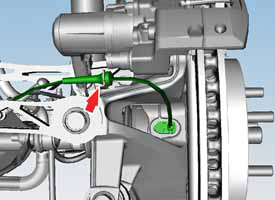Tesla Model S: Oil Seal - Differential to Driveshaft Assembly - LH (Remove and Replace)
Special tools required for this procedure:
| Supplier | Part Number | Description |
| Tesla | 1051509-00-A | Output Seal Installation Tool |
| Tesla | 1052583-00-A | Seal Puller Note: Technicians may use this tool or equivalent. |
| Tesla | 1057312-00-A | Axle Extractor |
- If the vehicle has air suspension, use Toolbox to depressurize the air spring back to the reservoir (refer to procedure).
- On the touchscreen, touch Controls > E-Brake and Power Off > Tow Mode. Warning: Once "Tow Mode" is selected, the vehicle is in Neutral.
- Remove the road wheel (refer to procedure).
- Remove the mid aero shield (refer to procedure).
- Drain the gearbox fluid (refer to procedure). Note: It is not necessary to drain the gearbox fluid if the vehicle is level throughout this procedure.
- Disconnect the toe link from the LH knuckle (torque 130 Nm).

- Disconnect the upper link from the knuckle (torque 140 Nm).

- Remove the park brake caliper (refer to procedure).
- Release the wheel speed sensor harness from the securing clip
and bracket.

- Disconnect the shock absorber from the knuckle (torque 140 Nm).
Tip: If necessary, use a pry bar or drift punch to align the lower shock bushing while removing the bolt.

- Use the axle extractor tool to release the driveshaft from the
transmission. Rest the driveshaft on the lower control arm.
Caution: Ensure that the axle extractor tool does not contact any of the differential retaining studs.
Caution: Do not strain the brake hose or electrical wiring while pulling the knuckle.
Note: Place suitable absorbent material around the affected area to absorb any fluid spillage.



- Protect the driveshaft's output flange oil seal face and spline to prevent damage.
- Using 1052583-00-A or an equivalent seal puller, remove the output shaft oil seal from the differential casing.
Caution: Plug the transmission to prevent ingress of dirt or moisture.

Installation procedure is the reverse of removal, except for the following:
Caution: Ensure that the mating faces are clean and free from debris.
Caution: Do not reuse the snap-ring. Install a new snap-ring before reinstalling the driveshaft.

Caution: Ensure that the bolt that secures the spring assembly to the knuckle is inserted towards the rear of the vehicle; the head of the bolt faces the front of the vehicle and the nut is tightened at the rear.
Tip: It might be helpful to lift the lower control arm with a floor jack to line up the rear suspension during reassembly. Do not torque the bolts at this time.
Caution: Only fully tighten suspension nuts and bolts when the vehicle is on a 4-post lift and the suspension is in the ride height position.
- When installing the driveshaft into the drive unit:
- Ensure that the opening of the snap ring is facing towards the bottom of the drive unit.
- Do not damage or displace the oil seal.
- Verify that the driveshaft is fully seated by carefully pushing it into the drive unit until there is an audible "click" from the snap ring.
- Check and top up gearbox fluid.
- Check the differential casing oil seal register for burrs and other damage.
- Using the 1051509-00-A output seal installation tool, install a new output shaft oil seal.

